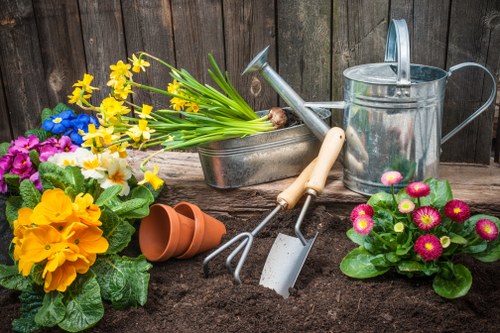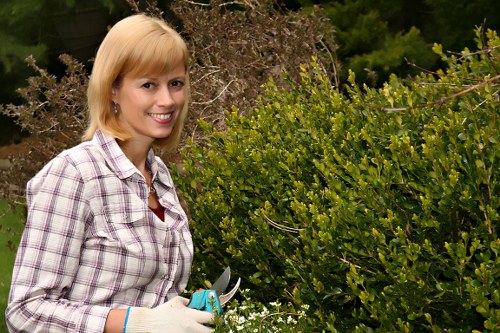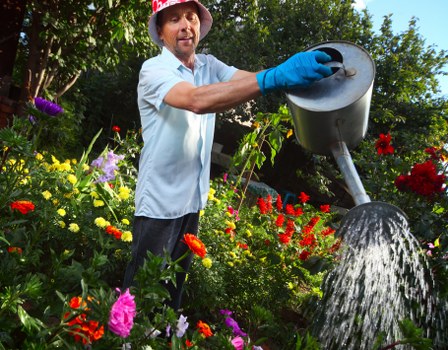Hedge Trimming in Thamesmead: Maintaining Pristine Green Spaces
Why Hedge Trimming is Essential

Maintaining your hedges is crucial for both aesthetic and practical reasons. Proper hedge trimming ensures that your garden looks well-kept and enhances the overall curb appeal of your property in Thamesmead.
Regular trimming promotes healthy growth by removing dead or diseased branches, allowing for better air circulation and sunlight penetration. This practice prevents pests and diseases from taking hold, ensuring your hedges remain vibrant and lush throughout the year.
In addition to health benefits, well-trimmed hedges serve as natural barriers, providing privacy and reducing noise pollution from the surrounding areas. They also act as windbreaks, protecting your home from harsh weather conditions.
Types of Hedges Suitable for Thamesmead Gardens

Choosing the right type of hedge is vital for achieving the desired look and functionality in your garden. Thamesmead offers a variety of climates and soil conditions, making it essential to select hedges that thrive in these environments.
Common Types of Hedges:
- Privet Hedging: Fast-growing and dense, ideal for privacy screens.
- Boxwood: Evergreen with small leaves, perfect for formal gardens.
- Laurel: Robust and lush, excellent for creating thick barriers.
- Bamboo: Adds a unique aesthetic, although it requires containment to prevent spreading.
Each variety has its specific trimming needs, so understanding the characteristics of your chosen hedge is essential for effective maintenance.
Best Practices for Trimming Hedges

Effective hedge trimming involves more than just cutting back branches. It requires careful planning and execution to ensure the health and appearance of your hedges.
Steps for Proper Hedge Trimming:
- Assess the Hedges: Identify the type of hedge and its specific trimming requirements.
- Gather the Right Tools: Use quality shears, loppers, and possibly a hedge trimmer for larger areas.
- Trim During the Right Season: Late spring to early summer is generally the best time for most hedges.
- Maintain a Consistent Shape: Aim for uniformity to enhance the visual appeal.
- Regular Maintenance: Schedule trims every few months to prevent overgrowth.
Adhering to these practices ensures your hedges remain healthy, attractive, and functional.
Tools and Equipment for Hedge Trimming

Having the right tools is essential for efficient and effective hedge trimming. Investing in quality equipment not only makes the job easier but also ensures a clean cut that promotes healthy growth.
Essential Tools:
- Manual Hedge Shears: Ideal for small to medium-sized hedges.
- Electric or Gas Hedge Trimmers: Suitable for larger or denser hedges.
- Loppers: Useful for cutting thicker branches.
- Protective Gear: Gloves, safety glasses, and sturdy footwear to ensure safety.
- Pruning Saw: For removing larger sections of the hedge when necessary.
Regular maintenance of these tools, such as sharpening blades and cleaning, extends their lifespan and ensures optimal performance.
Hiring Professional Hedge Trimming Services in Thamesmead

While DIY hedge trimming is possible, hiring professional services offers numerous advantages, especially for larger properties or intricate garden designs.
Benefits of Professional Services:
- Expertise: Trained professionals understand the specific needs of different hedge types.
- Time-Saving: Professionals can complete the job efficiently, freeing up your time.
- Proper Equipment: Access to specialized tools ensures high-quality trimming.
- Safety: Professionals are equipped to handle potentially hazardous tasks safely.
Engaging local Thamesmead hedge trimming experts can provide tailored solutions that enhance the beauty and health of your garden.
Seasonal Hedge Trimming Tips
Different seasons require different approaches to hedge trimming to ensure optimal growth and appearance.
Spring Trimming: Focus on encouraging new growth by removing any winter damage and lightly shaping the hedges.
Summer Trimming: Maintain shape and size, ensuring the hedges do not become overgrown.
Autumn Trimming: Prepare hedges for winter by cutting back any weak or diseased branches.
Winter Trimming: Generally not recommended unless necessary to remove dead or damaged wood.
Understanding these seasonal needs helps in planning your hedge maintenance schedule effectively.
Common Hedge Trimming Mistakes to Avoid
Avoiding common mistakes ensures the health and longevity of your hedges.
Over-Trimming: Cutting back too much can stress the plant and hinder growth.
Incorrect Timing: Trimming at the wrong time of year can disrupt the plant's growth cycle.
Using Dull Tools: Can cause ragged cuts that are more susceptible to disease.
Ignoring Shape and Symmetry: Leads to an untidy appearance and uneven growth.
Being mindful of these pitfalls helps maintain the integrity and beauty of your hedges.
Eco-Friendly Hedge Trimming Practices
Adopting sustainable practices in hedge trimming contributes to environmental conservation.
Using Electric Tools: Reduce carbon emissions compared to gas-powered equipment.
Composting Clippings: Recycle hedge trimmings to enrich your garden soil.
Water Conservation: Trim hedges in a way that reduces water usage for maintenance.
Native Plants: Choose hedge varieties that are native to Thamesmead, promoting local biodiversity.
Implementing these eco-friendly methods not only benefits the environment but also enhances the sustainability of your garden.
Cost Considerations for Hedge Trimming in Thamesmead
Understanding the costs associated with hedge trimming helps in budgeting for garden maintenance.
Factors Influencing Cost:
- Size of the Hedges: Larger hedges require more time and resources to trim.
- Type of Hedges: Some plants are more labor-intensive to maintain.
- Frequency of Trimming: Regular maintenance can be more cost-effective in the long run.
- Professional vs. DIY: Hiring experts involves higher upfront costs but ensures quality results.
Balancing these factors helps in making informed decisions about your hedge trimming needs.
Maintaining Hedge Health After Trimming
Proper care post-trimming ensures that your hedges recover quickly and continue to thrive.
Post-Trimming Care Tips:
- Watering: Ensure hedges receive adequate moisture, especially during dry periods.
- Fertilizing: Provide necessary nutrients to support new growth.
- Monitoring for Pests: Regularly check for signs of infestation or disease.
- Mulching: Apply mulch to retain soil moisture and suppress weeds.
Following these steps promotes the long-term health and beauty of your hedges.
Integrating Hedges into Overall Garden Design
Hedges can significantly influence the layout and ambiance of your garden when integrated thoughtfully.
Design Tips:
- Symmetrical Layout: Creates a formal and organized garden appearance.
- Natural Shapes: For a more relaxed and organic garden feel.
- Layering: Combine different types of hedges for depth and variety.
- Pathways: Use hedges to define walking paths and guide visitors through your garden.
Strategic placement and styling of hedges can enhance both the functionality and visual appeal of your outdoor space.
Seasonal Flowering Hedges: Adding Color Throughout the Year
Incorporating flowering hedges brings vibrant colors and attracts pollinators to your garden.
Popular Flowering Hedges:
- Rhododendron: Large blooms and evergreen foliage.
- Camellia: Beautiful flowers in various colors, suitable for shaded areas.
- Spiraea: Delicate flowers and attractive fall color.
- Lilac: Fragrant blooms and lovely spring flowers.
These hedges not only add aesthetic value but also contribute to a lively and dynamic garden environment.
Common Questions About Hedge Trimming in Thamesmead
Addressing frequently asked questions helps homeowners make informed decisions about their hedge maintenance.
- How often should I trim my hedges? Typically, hedges should be trimmed 2-3 times a year, depending on the growth rate.
- What is the best time of year to trim hedges? Late spring to early summer is ideal for most hedges, but some may require trimming in different seasons.
- Can I trim my hedges myself? Yes, if you have the right tools and knowledge. However, professional services ensure precision and expertise.
- What size hedges can professionals handle? Professionals can manage hedges of all sizes, from small garden borders to large property hedges.
- Are there eco-friendly options for hedge trimming? Absolutely. Using electric tools, composting clippings, and selecting native plants are great eco-friendly practices.
These answers provide clarity and assist in effective hedge maintenance planning.
Conclusion: Achieving Beautiful Hedges in Thamesmead
Hedge trimming is a vital aspect of garden maintenance that enhances the beauty, health, and functionality of your outdoor space. Whether you choose to undertake this task yourself or hire professionals in Thamesmead, understanding the best practices, tools, and seasonal needs ensures your hedges remain a stunning feature of your garden.
Ready to transform your garden? Contact us today to schedule your hedge trimming service and enjoy a beautifully manicured garden all year round.